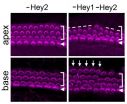(Press-News.org) New research led by the University of Leicester in the UK gives a blow-by-blow account of the injuries inflicted on King Richard III's body at the Battle of Bosworth Field on Aug 22, 1485. Modern forensic analysis of the King's skeletal remains reveals that three of his injuries had the potential to cause death quickly—two to the skull (page 4, figure 4) and one to the pelvis (page 5, figure 6).
The remains of King Richard III—the last English monarch to die in battle—were found under a car park in Leicester by archaeologists from the University of Leicester, and subsequently identified by a multidisciplinary team from the University.
The forensic imaging team, working with the Forensic Pathology Unit and the Department of Engineering at the University of Leicester, used whole body CT scans and micro-CT imaging of injured bones to analyse trauma to the 500-year-old skeleton carefully, and to determine which of the King's wounds might have proved fatal. They also analysed tool marks on bone to identify the medieval weapons potentially responsible for his injuries.
The results, published in The Lancet, show that Richard's skeleton sustained 11 wounds at or near the time of his death—nine of them to the skull, clearly inflicted in battle and suggesting he had removed or lost his helmet, and two to the postcranial skeleton.
Sarah Hainsworth, study author and Professor of Materials Engineering at the University of Leicester explains, "Richard's injuries represent a sustained attack or an attack by several assailants with weapons from the later medieval period. The wounds to the skull suggest that he was not wearing a helmet, and the absence of defensive wounds on his arms and hands indicate that he was otherwise still armoured at the time of his death."*
The investigators, led by Dr Jo Appleby of the University of Leicester School of Archaeology and Ancient History, surmise that the postcranial injuries, including the potentially fatal one to the pelvis, might have been inflicted after Richard's death, on the basis that had he been alive he would have been wearing a specific type of armour worn in the late 15th century that would have prevented such wounds (page 6, figure 7).
According to Professor Guy Rutty, study co-author, from the East Midlands Pathology Unit at the University of Leicester, "The most likely injuries to have caused the King's death are the two to the inferior aspect of the skull—a large sharp force trauma possibly from a sword or staff weapon, such as a halberd or bill, and a penetrating injury from the tip of an edged weapon. Richard's head injuries are consistent with some near-contemporary accounts of the battle, which suggest that Richard abandoned his horse after it became stuck in a mire and was killed while fighting his enemies."*
Commenting on the research, Dr Heather Bonney from the Natural History Museum in London, UK, says, "Appleby and colleagues provide a compelling account, giving tantalising glimpses into the validity of the historic accounts of his death, which were heavily edited by the Tudors in the following 200 years. Wherever his remains are again laid to rest, I am sure that Richard III will continue to divide opinion fiercely for centuries to come."
INFORMATION:
Notes to Editors:
The Dig for Richard III was led and funded by the University of Leicester, working with Leicester City Council and in association with the Richard III Society. The originator of the Search project was Philippa Langley of the Richard III Society.
*Quotes direct from authors and cannot be found in text of Article.
The Lancet: Scientists use modern forensic techniques to identify most likely cause of King Richard III's death
2014-09-17
ELSE PRESS RELEASES FROM THIS DATE:
Urine HPV test could offer non-invasive alternative to conventional smear, improve screening uptake
2014-09-17
Human papillomavirus (HPV) is one of the most common sexually transmitted infections. Up to 80% of sexually active women are infected at some point in their lives and infection with specific "high risk" strains of HPV has an established link to cervical cancer.
Current screening by cervical cytology (smear test) is invasive and time-consuming - and in recent years, cervical screening in the UK has fallen below 80%, particularly amongst women aged 25-30. Several studies have suggested that detecting HPV in urine may be a feasible alternative to cervical sampling, but the ...
Hey1 and Hey2 ensure inner ear 'hair cells' are made at the right time, in the right place
2014-09-17
Two Johns Hopkins neuroscientists have discovered the "molecular brakes" that time the generation of important cells in the inner ear cochleas of mice. These "hair cells" translate sound waves into electrical signals that are carried to the brain and are interpreted as sounds. If the arrangement of the cells is disordered, hearing is impaired.
A summary of the research will be published in The Journal of Neuroscience on Sept. 16.
"The proteins Hey1 and Hey2 act as brakes to prevent hair cell generation until the time is right," says Angelika Doetzlhofer, Ph.D., an ...
36 Pit Fire in Oregon
2014-09-17
The 36 Pit Fire began on September 13, 2014. The fire is human-caused and is still under investigation. It is currently over 2,300 acres in size and is mostly being fueled by grass and timber. The 36 Pit Fire was calm Monday night due to higher humidity. Yesterday (8/15), firefighters made progress in establishing an anchor point and beginning to construct a fireline on the West and North sides of the fire.
The following resources are working on the fire:
7 20-person Crews
4 Hot Shot Crews
1 large Type 1 Helicopter
2 medium Type 2 Helicopter
2 bulldozer
17 ...
Focus on treatment costs, value: Less radiation for elderly women with early breast cancer
2014-09-16
(September 16th, 2014; San Francisco) – In a healthcare climate where the costs of treatment are increasingly weighed against potential benefit, a Yale study has found that radiation oncologists are using fewer or less-aggressive radiation procedures on elderly women with early-stage breast cancer. The findings are scheduled to be presented at the 56th annual conference of the American Society for Radiation Oncology in San Francisco. (Abstract 131: Evaluating National Practice in Radiotherapy for Elderly Women: Response to a Randomized Trial and Cost Effectiveness on a ...
Effect of magnesium sulfate during pregnancy on very preterm infants
2014-09-16
Magnesium sulfate given intravenously to pregnant women at risk of very preterm birth was not associated with benefit on neurological, behavioral, growth, or functional outcomes in their children at school age, according to a study in the September 17 issue of JAMA.
Rates of adverse long-term neurodevelopmental outcomes for infants born at less than 28 weeks' gestation remain high relative to full-term infants. Among the multiple uses for magnesium sulfate in obstetrics is as a neuroprotectant for preterm fetuses. Antenatal (before birth) magnesium sulfate given to pregnant ...
Waistlines of US adults continue to increase
2014-09-16
The prevalence of abdominal obesity and average waist circumference increased among U.S. adults from 1999 to 2012, according to a study in the September 17 issue of JAMA.
Waist circumference is a simple measure of total and intra-abdominal body fat. Although the prevalence of abdominal obesity has increased in the United States through 2008, its trend in recent years has not been known, according to background information in the article.
Earl S. Ford, M.D., M.P.H., of the U.S. Centers for Disease Control and Prevention, Atlanta, and colleagues used data from seven ...
Combination therapy for COPD associated with better outcomes
2014-09-16
Among older adults with chronic obstructive pulmonary disease (COPD), particularly those with asthma, newly prescribed long-acting beta-agonists (LABAs) and inhaled corticosteroid combination therapy, compared with newly prescribed LABAs alone, was associated with a lower risk of death or COPD hospitalization, according to a study in the September 17 issue of JAMA.
Chronic obstructive pulmonary disease is the third leading cause of death worldwide. Medications are a mainstay of COPD management, and knowing which are most effective in real-world practice is essential. ...
Study compares effectiveness of treatments for blood clots
2014-09-16
In an analysis of the results of nearly 50 randomized trials that examined treatments of venous thromboembolisms (blood clot in a vein), there were no significant differences in clinical and safety outcomes associated with most treatment strategies when compared with the low-molecular-weight heparin-vitamin K antagonist combination, according to a study in the September 17 issue of JAMA.
Venous thromboembolism, manifested as deep vein thrombosis or pulmonary embolism (blood clot in a lung), is a common medical condition and is the third leading cause of cardiovascular ...
New radiosurgery technology provides highly accurate treatment, greater patient comfort
2014-09-16
DETROIT – A new stereotactic radiosurgery system provides the same or a higher level of accuracy in targeting cancer tumors – but offers greater comfort to patients and the ability to treat multiple tumors at once – when compared to other radiation therapy stereotactic systems, according to researchers at Henry Ford Hospital in Detroit.
The study shows the Edge™ Radiosurgery Suite is able to target cancer tumors within 1 mm, providing sub-millimeter accuracy with extreme precision.
"Radiosurgery is just one shot of precision radiation with a very high dose to treat ...
Patient's question triggers important study about blood thinners
2014-09-16
Ottawa – September 16, 2014 – Physicians around the world now have guidance that can help them determine the best oral blood thinners to use for their patients suffering from blood clots in their veins, thanks to a patient of The Ottawa Hospital who asked his physician a question he couldn't answer. This new guidance is found in a study published today by JAMA, the Journal of the American Medical Association.
"Right there in the clinic, he identified an important knowledge gap for clinicians. We decided to act on it and find the answer," says hematologist Dr. Marc Carrier, ...


